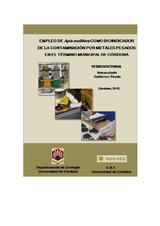Empleo de Apis mellifera como bioindicador de la contaminación de metales pesados en el término municipal de Córdoba
Autor
Gutiérrez Tirado, Inmaculada
Director/es
Ruiz Martínez, José AntonioMolero-Baltanás, Rafael
Editor
Universidad de Córdoba, UCOPressFecha
2016Materia
Apis melliferaBioindicadores
Contaminación
Metales pesados
Córdoba (España)
Biomonitoreo
METS:
Mostrar el registro METSPREMIS:
Mostrar el registro PREMISMetadatos
Mostrar el registro completo del ítemResumen
Las colonias de Apis mellifera Linnaeus, 1758 se han utilizado para
estudiar la contaminación ambiental debido a sus excepcionales características
como bioindicadores. El principal objetivo de este estudio fue utilizar colonias
de abejas para identificar metales pesados y determinar su utilidad en la
gestión medioambiental. Para analizar el nivel y la variación espacial y temporal
de la contaminación por Pb, Cr, Ni y Cd, cinco estaciones con dos colmenas de
A. mellifera fueron ubicadas estratégicamente en el término municipal de
Córdoba, en zonas urbanas, industriales, agrarias y forestales. Durante los
años 2007, 2009 y 2010, se recogieron muestras de abejas pecoreadoras y
néctar. La concentración de metales, en mg/kg de abejas y néctar, fue
determinada mediante espectrometría de emisión atómica de plasma acoplado
inductivamente y espectrofotometría de absorción atómica en horno de grafito.
Se evidenciaron diferencias significativas entre localizaciones y periodos, en
abejas y en néctar, ofreciendo una valoración cualitativa relevante. Desde el
punto de vista cuantitativo, abejas y néctar coincidieron en registrar las
mayores frecuebcias de valores Aceptables para el Pb, la Estación agrícola S2,
el año 2010 y el mes de Mayo. Del mismo modo coincidieron en registrar las
mayores frecuencias de valores Merecedores de atención para la Estación
industrial S5, el año 2007 y el mes de Junio, pero no así en el metal (Cr en
abejas y Ni en néctar). Por último, en cuanto a los valores Preocupantes, las
dos matrices difirieron en el metal (Ni en abejas y Cr en néctar), la Estación
(urbana S4 en abejas y forestal S3 en néctar), y el año (2007 en abejas y 2009
en néctar), coincidiendo sólo en el mes (Julio). En este caso, las dos matrices
ofrecieron una información complementaria. La concentración de Cd en abejas
y néctar alcanzó altas frecuencias de valores Preocupantes, aunque sólo fue
analizado en el año 2010. El biomonitoreo con A. mellifera podría formar parte
del sistema de vigilancia y control de la contaminación atmosférica, ya que
puede integrar valoraciones cualitativas y cuantitativas, facilitando la gestión
tanto de manera preventiva como ante la aparición de alertas y crisis
ambientales. Due to features that make them outstanding environmental bioindicators,
colonies of Apis mellifera Linnaeus, 1758 are being used to study environmental
pollution. The primary objective of this research was to use honeybee colonies
to identify heavy metals and determine their utility for environmental
management. Five stations, each with two A. mellifera hives, were strategically
located in urban, industrial, agricultural and forested areas within the
municipality of Córdoba (Spain), and foraging bees and nectar were collected in
2007, 2009 and 2010 to analyse the levels and spatial and temporal variations
in Pb, Cr, Ni and Cd pollution. Metal concentrations, in mg/kg of honeybee and
nectar, were determined using inductively coupled plasma-atomic emission
spectrometry and graphite furnace atomic absorption spectrophotometry.
Significant differences were found among the various locations and periods,
providing a significant qualitative assessment. From a quantitative viewpoint,
bees and nectar agreed to show that Pb, the agricultural station S2, year 2010
and the month of May showed the highest frequencies of Acceptable values.
Similarly, they agreed to show that industrial station S5, year 2007 and the
month of June, showed the highest frequency of values Worthy of attention, but
not in the metal (Cr in bees and Ni in nectar). Finally, regarding Worrisome
values, the two matrices differed in the metal (Ni in bees and Cr in nectar), the
station (urban S4 in bees and forest S3 in nectar), and the year (2007 in bees
and 2009 in nectar), coinciding in the month (July). In this case, the two
matrices offered additional information. The concentration of Cd in bees and
nectar had a high frequency of Worrisome values, although Cd was only
analysed in 2010. Biomonitoring with colonies of A. mellifera could contribute to
improved surveillance and control systems for atmospheric pollution by
integrating qualitative and quantitative assessments, thus facilitating prevention
and readiness in the event of environmental crises.

